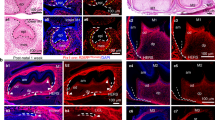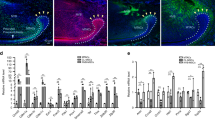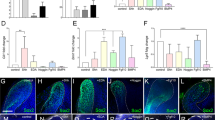Abstract
A number of studies have reported in the last decade that human tooth germs contain multipotent cells that give rise to dental and peri-odontal structures. The dental pulp, third molars in particular, have been shown to be a significant stem cell source. In this study, we isolated and characterized human tooth germ stem cells (hTGSCs) from third molars and assessed the expression of developmentally important transcription factors, such as oct4, sox2, klf4, nanog and c-myc, to determine their pluri-potency. Flow-cytometry analysis revealed that hTGSCs were positive for CD73, CD90, CD105 and CD166, but negative for CD34, CD45 and CD133, suggesting that these cells are mesenchymal-like stem cells. Under specific culture conditions, hTGSCs differentiated into osteogenic, adipogenic and neurogenic cells, as well as formed tube-like structures in Matrigel assay. hTGSCs showed significant levels of expression of sox2 and c-myc messenger RNA (mRNA), and a very high level of expression of klf4 mRNA when compared with human embryonic stem cells. This study reports for the first time that hTGSCs express developmentally important transcription factors that could render hTGSCs an attractive candidate for future somatic cell re-programming studies to differentiate germs into various tissue types, such as neurons and vascular structures. In addition, these multipotential hTGSCs could be important stem cell sources for autologous transplantation.
This is a preview of subscription content, access via your institution
Access options
Subscribe to this journal
Receive 6 print issues and online access
$259.00 per year
only $43.17 per issue
Buy this article
- Purchase on Springer Link
- Instant access to full article PDF
Prices may be subject to local taxes which are calculated during checkout









Similar content being viewed by others
References
Pittenger MF, Mackay AM, Beck SC, Jaiswal RK, Douglas R, Mosca JD et al. Multilineage potential of adult human mesenchymal stem cells. Science 1999; 284: 143–147.
Jones EA, Kinsey SE, English A, Jones RA, Straszynski L, Meredith DM et al. Isolation and characterization of bone marrow multipotential mesenchymal progenitor cells. Arthritis Rheum 2002; 46: 3349–3360.
Ferrari G, Cusella-De Angelis G, Coletta M, Paolucci E, Stornaiuolo A, Cossu G et al. Muscle regeneration by bone marrow-derived myogenic progenitors. Science 1998; 279: 1528–1530.
Ianus A, Holz GG, Theise ND, Hussain MA . In vivo derivation of glucose-competent pancreatic endocrine cells from bone marrow without evidence of cell fusion. J Clin Invest 2003; 111: 843–850.
Jiang Y, Jahagirdar BN, Reinhardt RL, Schwartz RE, Keene CD, Ortiz-Gonzalez XR et al. Pluripotency of mesenchymal stem cells derived from adult marrow. Nature 2002; 418: 41–49.
Mezey E, Key S, Vogelsang G, Szalayova I, Lange GD, Crain B . Transplanted bone marrow generates new neurons in human brains. Proc Natl Acad Sci USA 2003; 100: 1364–1369.
Petersen BE, Bowen WC, Patrene KD, Mars WM, Sullivan AK, Murase N et al. Bone marrow as a potential source of hepatic oval cells. Science 1999; 284: 1168–1170.
Campagnoli C, Roberts IA, Kumar S, Bennett PR, Bellantuono I, Fisk NM . Identification of mesenchymal stem/progenitor cells in human first-trimester fetal blood, liver, and bone marrow. Blood 2001; 98: 2396–2402.
De Bari C, Dell’Accio F, Tylzanowski P, Luyten FP . Multipotent mesenchymal stem cells from adult human synovial membrane. Arthritis Rheum 2001; 44: 1928–1942.
Salingcarnboriboon R, Yoshitake H, Tsuji K, Obinata M, Amagasa T, Nifuji A et al. Establishment of tendon-derived cell lines exhibiting pluripotent mesenchymal stem cell-like property. Exp Cell Res 2003; 287: 289–300.
Toma JG, McKenzie IA, Bagli D, Miller FD . Isolation and characterization of multipotent skin-derived precursors from human skin. Stem Cells 2005; 23: 727–737.
Zuk PA, Zhu M, Ashjian P, De Ugarte DA, Huang JI, Mizuno H et al. Human adipose tissue is a source of multipotent stem cells. Mol Biol Cell 2002; 13: 4279–4295.
Graziano A, d’Aquino R, Laino G, Papaccio G . Dental pulp stem cells: a promising tool for bone regeneration. Stem Cell Rev 2008; 4: 21–26.
Bosshardt DD . Are cementoblasts a subpopulation of osteoblasts or a unique phenotype? J Dent Res 2005; 84: 390–406.
Gronthos S, Mankani M, Brahim J, Robey PG, Shi S . Postnatal human dental pulp stem cells (DPSCs) in vitro and in vivo. Proc Natl Acad Sci USA 2000; 97: 13625–13630.
Miura M, Gronthos S, Zhao M, Lu B, Fisher LW, Robey PG et al. SHED: stem cells from human exfoliated deciduous teeth. Proc Natl Acad Sci USA 2003; 100: 5807–5812.
Seo BM, Miura M, Gronthos S, Bartold PM, Batouli S, Brahim J et al. Investigation of multipotent postnatal stem cells from human periodontal ligament. Lancet 2004; 364: 149–155.
Ikeda E, Hirose M, Kotobuki N, Shimaoka H, Tadokoro M, Maeda M et al. Osteogenic differentiation of human dental papilla mesenchymal cells. Biochem Biophys Res Commun 2006; 342: 1257–1262.
Yao S, Norton J, Wise GE . Stability of cultured dental follicle cells. Cell Prolif 2004; 37: 247–254.
Morsczeck C, Gotz W, Schierholz J, Zeilhofer F, Kuhn U, Mohl C et al. Isolation of precursor cells (PCs) from human dental follicle of wisdom teeth. Matrix Biol 2005; 24: 155–165.
Ten Cate AR, Mills C . The development of the periodontium: the origin of alveolar bone. Anat Rec 1972; 173: 69–77.
Park BW, Hah YS, Kim DR, Kim JR, Byun JH . Osteogenic phenotypes and mineralization of cultured human periosteal-derived cells. Arch Oral Biol 2007; 52: 983–989.
Lindroos B, Maenpaa K, Ylikomi T, Oja H, Suuronen R, Miettinen S . Characterisation of human dental stem cells and buccal mucosa fibroblasts. Biochem Biophys Res Commun 2008; 368: 329–335.
Yalvac ME, Ramazanoglu M, Gumru OZ, Sahin F, Palotas A, Rizvanov AA . Comparison and optimisation of transfection of human dental follicle cells, a novel source of stem cells, with different chemical methods and electro-poration. Neurochem Res 2009; 34: 1272–1277.
Iohara K, Zheng L, Ito M, Tomokiyo A, Matsushita K, Nakashima M . Side population cells isolated from porcine dental pulp tissue with self-renewal and multipotency for dentinogenesis, chondrogenesis, adipogenesis, and neurogenesis. Stem Cells 2006; 24: 2493–2503.
Jo YY, Lee HJ, Kook SY, Choung HW, Park JY, Chung JH et al. Isolation and characterization of postnatal stem cells from human dental tissues. Tissue Eng 2007; 13: 767–773.
Ikeda E, Yagi K, Kojima M, Yagyuu T, Ohshima A, Sobajima S et al. Multipotent cells from the human third molar: feasibility of cell-based therapy for liver disease. Differentiation 2008; 76: 495–505.
Takeda T, Tezuka Y, Horiuchi M, Hosono K, Iida K, Hatakeyama D et al. Characterization of dental pulp stem cells of human tooth germs. J Dent Res 2008; 87: 676–681.
Takahashi K, Yamanaka S . Induction of pluripotent stem cells from mouse embryonic and adult fibroblast cultures by defined factors. Cell 2006; 126: 663–676.
Park IH, Zhao R, West JA, Yabuuchi A, Huo H, Ince TA et al. Reprogramming of human somatic cells to pluripotency with defined factors. Nature 2008; 451: 141–146.
Kim JB, Zaehres H, Wu G, Gentile L, Ko K, Sebastiano V et al. Pluripotent stem cells induced from adult neural stem cells by reprogramming with two factors. Nature 2008; 454: 646–650.
Lagarkova MA, Volchkov PY, Lyakisheva AV, Philonenko ES, Kiselev SL . Diverse epigenetic profile of novel human embryonic stem cell lines. Cell Cycle 2006; 5: 416–420.
Gage FH . Mammalian neural stem cells. Science 2000; 287: 1433–1438.
Kafienah W, Mistry S, Williams C, Hollander AP . Nucleostemin is a marker of proliferating stromal stem cells in adult human bone marrow. Stem Cells 2006; 24: 1113–1120.
Pesce M, Anastassiadis K, Scholer HR . Oct-4: lessons of totipotency from embryonic stem cells. Cells Tissues Organs 1999; 165: 144–152.
Reyes M, Dudek A, Jahagirdar B, Koodie L, Marker PH, Verfaillie CM . Origin of endothelial progenitors in human postnatal bone marrow. J Clin Invest 2002; 109: 337–346.
Annabi B, Lee YT, Turcotte S, Naud E, Desrosiers RR, Champagne M et al. Hypoxia promotes murine bone-marrow-derived stromal cell migration and tube formation. Stem Cells 2003; 21: 337–347.
McLaughlin D, Tsirimonaki E, Vallianatos G, Sakellaridis N, Chatzistamatiou T, Stavropoulos-Gioka C et al. Stable expression of a neuronal dopaminergic progenitor phenotype in cell lines derived from human amniotic fluid cells. J Neurosci Res 2006; 83: 1190–1200.
Xiao ZS, Quarles LD, Chen QQ, Yu YH, Qu XP, Jiang CH et al. Effect of asymmetric dimethylarginine on osteoblastic differentiation. Kidney Int 2001; 60: 1699–1704.
Yoon SY, Park KS, Choi BS, Khang G, Kim MS, Rhee JM et al. Effect of DBP/PLGA hybrid scaffold on angiogenesis during the repair of calvarial bone defect. Key Eng Mater 2007; 342–343: 161–164.
Somogyi R, Wen X, Ma W, Barker JL . Developmental kinetics of GAD family mRNAs parallel neurogenesis in the rat spinal cord. J Neurosci 1995; 15: 2575–2591.
Saji M, Xydas S, Westra WH, Liang CK, Clark DP, Udelsman R et al. Human telomerase reverse transcriptase (hTERT) gene expression in thyroid neoplasms. Clin Cancer Res 1999; 5: 1483–1489.
Tare RS, Howard D, Pound JC, Roach HI, Oreffo RC . Tissue engineering strategies for cartilage generation micromass and three dimensional cultures using human chondrocytes and a continuous cell line. Biochem Biophys Res Commun 2005; 333: 609–621.
Kameda Y, Arai Y, Nishimaki T . Ultrastructural localization of vimentin immunoreactivity and gene expression in tanycytes and their alterations in hamsters kept under different photoperiods. Cell Tissue Res 2003; 314: 251–262.
Acknowledgements
This study was supported by Yeditepe University, the Russian Foundation for Basic Research grants, Russian Federal Agency for Science and Innovations government contract and by Asklepios-Med Bt. AAR was supported in part by the NATO reintegration grant NR.RIG.983007. All individuals included as authors have contributed substantially to the scientific process leading up to the writing of the paper and all authors have made an important contribution to the drafting or critical revision of the paper regarding important intellectual content. Mehmet E Yalvac and Albert A Rizvanov had full access to all of the particulars in the study and take responsibility for the integrity of the information and the accuracy of data analysis.
Author information
Authors and Affiliations
Corresponding authors
Rights and permissions
About this article
Cite this article
Yalvac, M., Ramazanoglu, M., Rizvanov, A. et al. Isolation and characterization of stem cells derived from human third molar tooth germs of young adults: implications in neo-vascularization, osteo-, adipo- and neurogenesis. Pharmacogenomics J 10, 105–113 (2010). https://doi.org/10.1038/tpj.2009.40
Received:
Revised:
Accepted:
Published:
Issue Date:
DOI: https://doi.org/10.1038/tpj.2009.40
Keywords
This article is cited by
-
Oral cavity-derived stem cells and preclinical models of jaw-bone defects for bone tissue engineering
Stem Cell Research & Therapy (2023)
-
Stem cells and common biomaterials in dentistry: a review study
Journal of Materials Science: Materials in Medicine (2022)
-
Induced Neural Cells from Human Dental Pulp Ameliorate Functional Recovery in a Murine Model of Cerebral Infarction
Stem Cell Reviews and Reports (2022)
-
The effect of polyethylenglycol gel on the delivery and osteogenic differentiation of homologous tooth germ–derived stem cells in a porcine model
Clinical Oral Investigations (2021)
-
Dental mesenchymal stem cells and neuro-regeneration: a focus on spinal cord injury
Cell and Tissue Research (2020)



